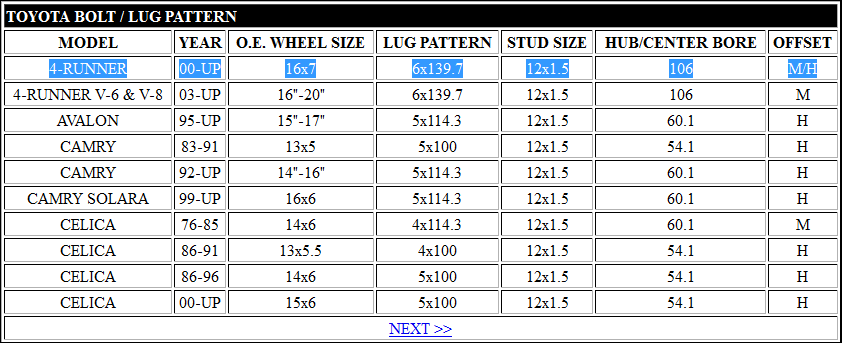Understanding The Wheel Bolt Pattern Of The 2025 Toyota 4Runner
Understanding the Wheel Bolt Pattern of the 2025 Toyota 4Runner
Related Articles: Understanding the Wheel Bolt Pattern of the 2025 Toyota 4Runner
Introduction
With enthusiasm, let’s navigate through the intriguing topic related to Understanding the Wheel Bolt Pattern of the 2025 Toyota 4Runner. Let’s weave interesting information and offer fresh perspectives to the readers.
Table of Content
Understanding the Wheel Bolt Pattern of the 2025 Toyota 4Runner

The Toyota 4Runner, a rugged and reliable SUV, has been a mainstay in the automotive landscape for decades. As the model progresses through its various iterations, understanding the intricacies of its design, including the wheel bolt pattern, becomes crucial for owners seeking to customize or maintain their vehicles. This article delves into the specifics of the 2025 4Runner’s wheel bolt pattern, explaining its significance and providing valuable insights for enthusiasts and owners.
The Importance of Wheel Bolt Pattern
The wheel bolt pattern, also known as the lug pattern, refers to the arrangement and spacing of the wheel bolts that secure the wheels to the vehicle’s hub. This pattern is a fundamental aspect of vehicle design, ensuring proper wheel fitment and safe operation. A mismatch in the bolt pattern can lead to:
- Incorrect Wheel Fitment: Wheels with an incompatible bolt pattern will not mount securely, leaving them prone to loosening or detaching during driving.
- Safety Hazards: Loose or misaligned wheels can cause severe accidents, endangering both the driver and other road users.
- Damage to Vehicle Components: Mismatched wheels can stress and damage the hub, suspension components, and other parts of the vehicle.
2025 4Runner Wheel Bolt Pattern
While specific details regarding the 2025 4Runner are yet to be officially released, based on the trends in previous model years, it is highly likely that the vehicle will retain the established 6-lug pattern. This pattern, commonly denoted as 6×139.7, signifies:
- 6 Lugs: There are six wheel bolts securing the wheel to the hub.
- 139.7mm Bolt Circle Diameter (BCD): The diameter of the imaginary circle passing through the centers of the bolt holes is 139.7 millimeters.
This pattern is prevalent across a range of Toyota models, including the Tacoma, Tundra, and various other SUVs.
Benefits of a Consistent Wheel Bolt Pattern
The consistent use of the 6×139.7 pattern across multiple Toyota models offers several benefits:
- Increased Compatibility: Owners have a wider selection of aftermarket wheels designed to fit their vehicles without requiring modifications.
- Simplified Maintenance: Replacing wheels or tires becomes a straightforward process, minimizing the risk of errors or complications.
- Cost-Effectiveness: The widespread use of this pattern allows for the availability of affordable replacement wheels and tires.
Considerations for Wheel Upgrades
While the 6×139.7 pattern offers compatibility with a wide range of wheels, it’s essential to consider additional factors when upgrading:
- Wheel Offset: This refers to the distance between the mounting surface of the wheel and the center of the wheel. Incorrect offset can affect handling, tire clearance, and overall aesthetics.
- Wheel Backspacing: This measures the distance from the mounting surface to the inside edge of the wheel. Incorrect backspacing can lead to tire rubbing against suspension components.
- Tire Size: Ensure the chosen tires are compatible with the vehicle’s specifications, considering factors such as load rating and speed rating.
FAQs Regarding the 2025 4Runner Wheel Bolt Pattern
Q: Will the 2025 4Runner have a different wheel bolt pattern than previous models?
A: Based on current trends, it is highly unlikely that the 2025 4Runner will deviate from the established 6×139.7 pattern. However, it’s always advisable to confirm the specifications with official sources closer to the vehicle’s release date.
Q: Can I use wheels from other Toyota models on my 2025 4Runner?
A: Many Toyota models share the 6×139.7 pattern, making it possible to use wheels from other vehicles, such as the Tacoma or Tundra. However, always verify the offset, backspacing, and tire size compatibility to ensure proper fitment and safety.
Q: Can I change the wheel bolt pattern of my 2025 4Runner?
A: While technically possible, changing the bolt pattern on a vehicle is a complex and potentially unsafe modification. It requires specialized tools, expertise, and should only be undertaken by qualified professionals.
Tips for Choosing Wheels for the 2025 4Runner
- Research and Verify: Before purchasing wheels, confirm the bolt pattern, offset, backspacing, and tire size compatibility with the 2025 4Runner specifications.
- Consult with Professionals: Seek advice from reputable tire and wheel specialists to ensure you make informed decisions regarding wheel upgrades.
- Prioritize Safety: Never compromise safety by using wheels that do not meet the vehicle’s specifications.
- Consider Aesthetics and Performance: Choose wheels that enhance the vehicle’s aesthetics while maintaining its performance capabilities.
Conclusion
The wheel bolt pattern plays a critical role in ensuring the safe and efficient operation of any vehicle, and the 2025 4Runner is no exception. By understanding the significance of this pattern and its implications for wheel compatibility, owners can make informed decisions regarding wheel upgrades and ensure a smooth and enjoyable driving experience. While the specific details for the 2025 model are yet to be released, the consistent use of the 6×139.7 pattern across previous 4Runner generations suggests that it will likely remain a defining characteristic of the upcoming model. By staying informed and prioritizing safety, owners can confidently navigate the world of wheel upgrades and personalize their 2025 4Runner to their liking.





Closure
Thus, we hope this article has provided valuable insights into Understanding the Wheel Bolt Pattern of the 2025 Toyota 4Runner. We appreciate your attention to our article. See you in our next article!